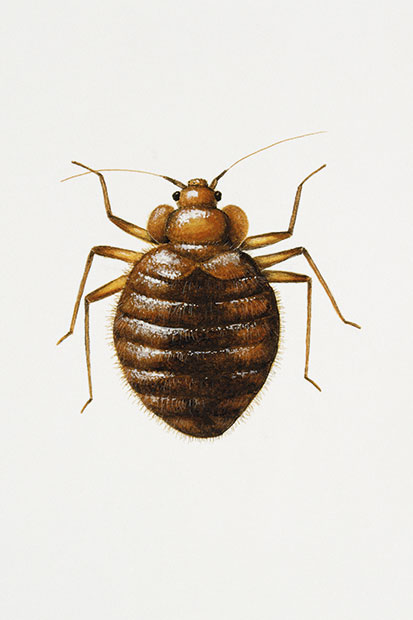‘Good night, sleep tight, don’t let the bedbugs bite,’ my mother used to say when she tucked me in at night, which may be why, like the author of this book, I never thought bedbugs were real. ‘Bedbugs? Are you crazy? That’s not even a real thing,’ Brooke Borel told her father (a pathologist who specialises in skin conditions). But as Mr Borel told his disbelieving daughter, bedbugs are real all right. They even have a fancy Latin name: Cimex lectularius. So, having been bitten to buggery (moral: never share a flat with someone who bought a used futon off the internet) Brooke Borel did what virtually every journalist ends up doing, eventually, and wrote a book about her misfortunes.
The result is a diverting study of a creature that’s been around a lot longer than we have, and will probably still be around long after we’ve all snuffed it. Bedbugs were biting humans long before humans invented beds, but when we invented modern pesticides, it looked like we had the blighters beat. After the second world war, we smothered everything with dichloro-diphenyltrichloroethane (DDT to you and me), naively believing it would finish off bedbugs for good.
However, creepy-crawlies adapt much faster than we do (shorter generations mean speedier mutations) and now bedbugs are back. All our attempts to eradicate them have merely bred better bugs. And by the time we’d worked out that DDT wasn’t terribly good for us either, it was already in the food chain, even in human breast milk. ‘The official stance of the US government and many other nations is that DDT is probably, but not definitely, carcinogenic,’ reports Borel. Whoops.
Borel got infested in New York, but now the bedbug comeback has gone global, and it seems we’re all to blame. The more we travel, the more bedbugs hitch a ride. They love big cities. They love central heating. The more cosy we make things, the more comfy they become. ‘We created the modern bedbug,’ writes Borel. ‘It evolved to live on us and to follow us. We became an efficient vehicle to spread it around the world.’
The more you learn about bedbugs, the less you’ll like the idea of finding them beneath your duvet. They inject saliva into your bloodstream, which acts as an anti-coagulant. Their bites can become infected, resulting in itchy red welts and sometimes blisters. After they’ve feasted on your blood, they like to engage in rough and tumble sex (not with you, fortunately). Once you’ve got them, it’s very hard to get rid of them. They adapt their mealtimes to your bedtimes. If you work nights, they do the day shift. If you work nine to five, they feed at night. They can trigger asthma and anaphylactic shocks. Psychological effects range from insomnia to suicide. The only good news is, they don’t seem to carry any known diseases — yet.
Bedbugs used to feed off bats that slept in caves, and started feeding off us when we became cavemen. Like all successful parasites, they adapted to hunt their new (human) prey: bigger mouths (all the better for biting with) and longer legs (so they could run away when we tried to swat them). Literature is full of them, from Horace to Henry Miller. They crop up in the Talmud, in Aristotle and Aristophanes.
Bizarrely, they haven’t always been regarded as an outright nuisance. The Ancient Greeks reckoned they were an antidote to snakebites, and Pliny thought they could cure earache. Wild West quacks hawked them as a remedy for haemorrhoids and constipation. Sadly, bedbugs are no earthly use to us, though we’re extremely useful to them.
Borel knows her stuff, but she also knows how to write; her clear and chatty prose turns what ought to be a dreary treatise into an entertaining read. She makes complicated things sound simple. She isn’t afraid to tell the boffins when she doesn’t get it, and make them spell it out. As well as summarising their findings, Borel provides a colourful history of their research trips, bringing her interviewees to life.
Her unlikely heroes include Robert Usinger, an ‘entomological Indiana Jones’ who travelled as far afield as the Congo in search of specimens. Borel follows in his footsteps, to some bat-infested attics in the Czech Republic. She even attends a bedbug summit in Las Vegas. It’s hardly Raiders of the Lost Ark, but she writes about her adventures in a lively and engaging manner, and what starts as a popular science primer ends up doubling as an atmospheric travelogue.
Like millions of bone-idle schoolboys, I dropped science as soon as possible, so (as you can probably tell from this review) I know next to nothing about how the world around me works. Now I find biology fascinating; but I need to be told about it in layman’s terms, so books like Infested are just the ticket. All I now need is a load of other books about all the other scientific stuff I know nowt about. Maybe Borel should do a series. After all, if she can make bedbugs interesting, she ought to be able to write about almost anything. How about a book on head lice? My children are infested with them.
Available from the Spectator Bookshop, £16.50 Tel: 08430 600033






Comments